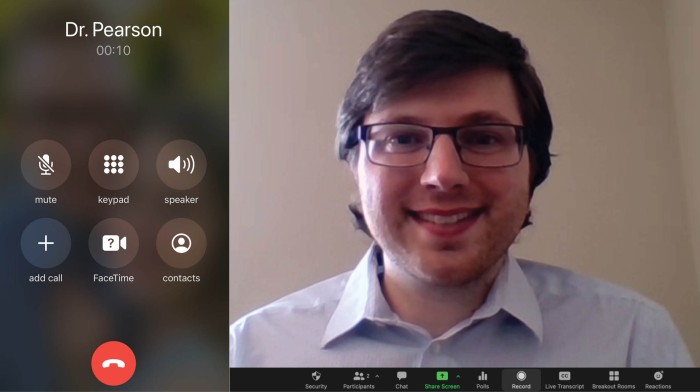
Telehealth use in dermatology has seen rapid growth over the past two years, largely as a result of mitigation measures related to the COVID-19 pandemic. While many of those measures have been reduced or will eventually come to a close, teledermatology is one that has seen a substantial increase in demand.
Enter David Pearson, MD, a dermatologist with University of M Physicians (M Physicians). Dr. Pearson began seeing telehealth patients in March 2020 and has been M Physicians’ full-time telehealth dermatologist since January 2021. For Dr. Pearson, teledermatology is about helping patients access personalized care without the wait or travel.
How teledermatology works
Virtual visits with patients usually start asynchronously with a patient sharing images of the affected areas ahead of the appointment. Then, they will talk with their doctor over the phone or occasionally on video about their concerns and next steps, Dr. Pearson explains. “It might seem counterintuitive to conduct these visits over the phone and with photos, but images are usually higher quality and more reliable than a live video camera. It works really well.”
What each teledermatology visit looks like is unique for each patient, Dr. Pearson says. “Because of the flexibility telehealth allows, we can tailor each patient’s experience to their needs and conditions in a timely manner.”
During the visit, if the dermatologist sees something concerning or if there are spots that may require closer examination, Dr. Pearson says that they are able to schedule in-person visits for patients on the order of days to weeks instead of months. “Teledermatology allows us to be much more flexible with scheduling, so we can make in-person appointments for patients who may more immediately need them.”
Improved access is one of the most significant factors patients and healthcare providers value about teledermatology, according to Dr. Pearson. Patients may wait up to three months or more to see a dermatologist in-person after being referred by their primary care physician. “In most cases, we can bring that time down to a few weeks or days, depending on the urgency,” Dr. Pearson says. For patients who do not live near where a dermatologist practices, they may also need to travel a significant distance for a potentially short in-person visit, potentially missing work or having to arrange alternative childcare.
Even patients who see a dermatologist more regularly save time and travel by connecting with a dermatologist virtually. Dr. Pearson notes that particularly for patients who need spot checks or who have recurring checkups related to treatment for acne, rosacea, rashes or other chronic conditions, teledermatology offers an alternative. “These patients may not have to regularly commute into the clinic for routine follow ups, but when they do, we’re here and available for them.”
Teledermatology also offers advantages for referring physicians. “With our telehealth capabilities, primary care physicians from anywhere in our system are able to request a virtual consultation, an ‘eConsult,’ for a patient they are seeing with a skin concern. We’re currently addressing each request within an average of 25 hours,” Dr. Pearson says, noting, “For the 12-14% of patients who may need an in-person visit following the eConsult, we can usually schedule appointments for them within a couple weeks.”
What’s next for telehealth and dermatology
With continued developments in technology and increasing access, Dr. Pearson believes that unlike some pandemic measures that may come to an end, teledermatology is here to stay. “The benefits we’ve been able to realize for our patients and the more access we’re able to provide for new patients is outstanding,” he says.
Before the pandemic, Dr. Pearson says utilization of teledermatology was low and that many patients and experts feared health outcomes would be different between telehealth and in-person visits. “We have data that show patients’ outcomes for many diseases are the same between those who are treated primarily with telehealth care compared to in-person,” Dr. Pearson says. “Not every skin condition is amenable to teledermatology, but it’s become an extremely useful tool in the care of our patients.”
“Because of this success, we are going to continue supporting and building our teledermatology care services so we can continue to meet patients when and where they are.”